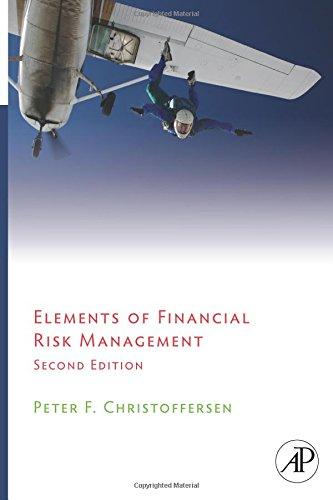Question
6. DEF Company is comparing three different capital structures. Plan I would result in 800 shares of stock and $9,000 in debt. Plan II would
6. DEF Company is comparing three different capital structures. Plan I would result in 800 shares of stock and $9,000 in debt. Plan II would result in 700 shares of stock and $13,500 in debt. Plan III is an all-equity plan and would result in 1,000 shares of stock. The firms EBIT will be $8,000 per year until infinity. The interest rate on the debt is 10%.
a. Ignoring taxes, compute the EPS for each of the three plans. Which of the three plans has the highest EPS? Which has the lowest?
b. Compute the break-even EBIT that will cause the EPS on Plan I to be equal to the all-equity EPS.
c. Compute the break-even EBIT that will cause the EPS on Plan II to be equal to the all-equity EPS.
d. Compare your results from parts (b) and (c) above. Is one higher than the other? Why?
e. Ignoring taxes, what is the break-even EBIT that will cause the EPS on Plan I to be equal to the EPS on Plan II? What conclusions do you reach when you compare the outcomes of parts (b), (c), and (e) above?
7. Q Corporation and R Inc. are two companies with very similar characteristics. The only difference between the two companies is that Q Corp. is an unlevered firm, and R Inc. is a levered firm with debt of $5 million and cost of debt of 10%. Both companies have earnings before interest and taxes (EBIT) of $2 million and a marginal corporate tax rate of 40%. Q Corp. has a cost of capital of 15%.
a. What is Qs firm value?
b. What is Rs firm value?
c. What is Rs equity value?
d. What is Qs cost of equity capital?
e. What is Rs cost of equity capital?
f. What is Qs WACC?
g. What is Rs WACC?
h. Compare the WACC of the two companies. What do you conclude?
i. What principle have you proven in this case?
j. Both companies are now evaluating a project that requires an initial investment of $1.15 million and that will yield cash inflows of $500,000 per year for the next three years. Assume that this project has the same risk level as the individual firms assets. Should Q invest in this project? Should R invest in this project?
k. Based on your results for part (j), discuss the effects of leverage and its tax shields effects on the future value of the two firms.
8. Mr. Toriop owns 5,000 shares of stock in Yummy Corporation. The company has announced that it will pay a dividend of $5 per share in one year and a liquidating dividend of $50 per share in two years. The required return on Yummy stock is 12%.
a. What is the current share price of your stock?
b. What will be the companys share price in one years time?
c. Mr. Toriop wishes to have equal amounts of dividend income for the next two years. How can he use homemade dividends to achieve this goal? Check that the present value of the cash flows will be the same as it is before the homemade dividends. (Hint: Dividends will be in the form of an annuity.)
d. Suppose Mr. Toriop is thinking about buying a house for $220,000 in one year. How can he use homemade dividends to achieve this goal? Check that the present value of the cash flows will be the same as it is before the homemade dividends. \
e. Suppose Mr. Toriop is thinking about postponing the house purchase for two years, by which time the price of the house will have increased by $46,800. How can he use homemade dividends to achieve this goal? Check that the present value of the cash flows will be the same as it is before the homemade dividends. (6 marks)
9. One argument for high dividend payout is the desire of investors for current income. Explain why this argument does/does not work in a perfect capital market with no transaction costs. Explain how this argument does/does not work in real life. (4 marks)
10. The management of Oodles of Noodles Inc. is contemplating a 30% stock dividend. The company currently has cash of $250,000, fixed assets of $5 million, and debt of $3 million. Its net income for the most recent fiscal year was $800,000. The companys shares are currently selling for $25 per share, and it has 1 million shares outstanding. Assume that there are no costs associated with issuing a stock dividend. (14 marks)
a. What would be the effect of such a stock dividend on the following?
i. Number of shares outstanding (1 mark)
ii. Earnings (1 mark)
iii. Market value of cash (1 mark)
iv. Market value of equity (1 mark)
v. Share price (2 marks)
vi. Earnings per share (EPS) (2 marks)
vii. Price-earnings ratio (P/E) (2 marks)
viii. Shareholders wealth (2 marks)
b. If the companys management would like to hold its EPS within the range of 0.70.9, should the company go ahead with the stock dividend? (1 mark)
c. If the companys shareholders only care about their wealth and the P/E ratio, should the company go ahead with the stock dividend? (1 mark)
Step by Step Solution
There are 3 Steps involved in it
Step: 1

Get Instant Access to Expert-Tailored Solutions
See step-by-step solutions with expert insights and AI powered tools for academic success
Step: 2

Step: 3

Ace Your Homework with AI
Get the answers you need in no time with our AI-driven, step-by-step assistance
Get Started


